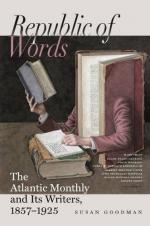The most remarkable display of crystallization which I have ever seen was on the 13th of January, 1859. There had been three days of unusual cold, but during the night the weather had moderated, and the mercury in the morning stood at + 14 deg.. About two inches of snow had fallen, and the trees appeared densely coated with it. It proved, on examination, that every twig had on the leeward side a dense row of miniature fronds or fern-leaves executed in snow, with a sharply defined central nerve, or midrib, and perfect ramification, tapering to a point, and varying in length from half an inch to three inches. On every post, every rail, and the corners of every building, the same spectacle was seen; and where the snow had accumulated in deep drifts, it was still made up of the ruins of these fairy structures. The white, enamelled landscape was beautiful, but a close view of the details was far more so. The crystallizations were somewhat uniform in structure, yet suggested a variety of natural objects, as feather-mosses, birds’ feathers, and the most delicate lace-corals, but the predominant analogy was with ferns. Yet they seemed to assume a sort of fantastic kindred with the objects to which they adhered: thus, on the leaves of spruce-trees and on delicate lichens they seemed like reduplications of the original growth, and they made the broad, fiat leaves of the arbor-vitae fully twice as wide as before. But this fringe was always on one side only, except when gathered upon dangling fragments of spider’s web, or bits of stray thread: these they entirely encircled, probably because these objects had twirled in the light wind while the crystals were forming. Singular disguises were produced: a bit of ragged rope appeared a piece of twisted lace-work; a knot-hole in a board was adorned with a deep antechamber of snowy wreaths; and the frozen body of a hairy caterpillar became its own well-plumed hearse. The most peculiar circumstance was the fact that single flakes never showed any regular crystallization: the magic was in the combination; the under sides of rails and boards exhibited it as unequivocally as the upper sides, indicating that the phenomenon was created in the lower atmosphere, and was more akin to frost than snow; and yet the largest snow-banks were composed of nothing else, and seemed like heaps of blanched iron-filings.
Interesting observations have been made on the relations between ice and snow. The difference seems to lie only in the more or less compacted arrangement of the frozen particles. Water and air, each being transparent when separate, become opaque when intimately mingled; the reason being that the inequalities of refraction break up and scatter every ray of light. Thus, clouds cast a shadow; so does steam; so does foam: and the same elements take a still denser texture when combined as snow. Every snow-flake is permeated with minute airy chambers, among which the light is bewildered and lost; while from perfectly




